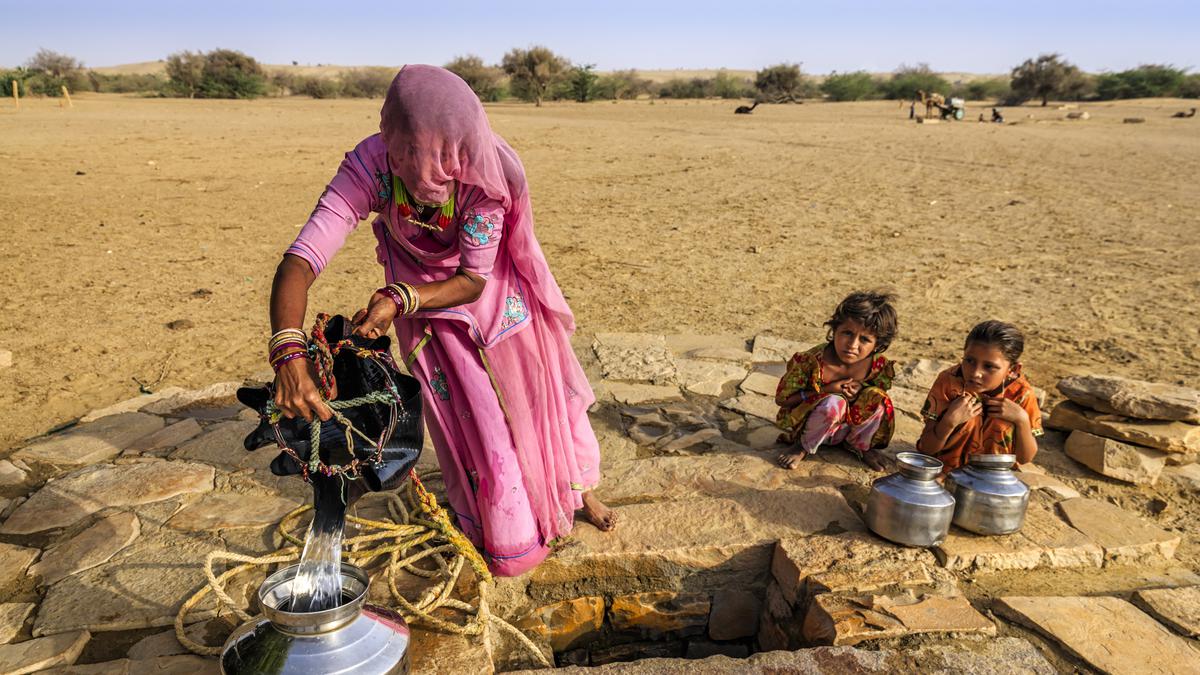Live Classes

In Context
Data show that India, with nearly 18% of the world’s population, occupies about 2.4% of the total geographical area and consumes 4% of total water resources. A World Bank report says that India is the largest groundwater user. A rapidly growing economy and population are straining the country’s groundwater resources.
Groundwater status and management in India
As a vast country, India has distinct and varying hydrogeological settings. Groundwater is the backbone of India’s agriculture and drinking water security in rural and urban areas, meeting nearly 80% of the country’s drinking water and two-thirds of its irrigation needs. Groundwater is pivotal to India’s water security. The fact that the theme of UN World Water Day 2022 was ‘Groundwater, Making the Invisible Visible’ is a reflection of the importance given to resources across the globe. The central government is working to achieve the goal of sustainable groundwater management in collaboration with States and Union Territories. In this process, certain important deliverables have been identified that include:
Jal Shakti Ministry and Campaign
In May 2019, a much-needed step of policy reform was done by creating a Jal Shakti Ministry (a merger of the erstwhile Ministries of Water Resources, River Development, and Ganga Rejuvenation along with Drinking Water and Sanitation). This was to give impetus to the management of water resources with a special focus on demand and supply management.
Realising the importance of community participation, Jal Shakti Abhiyan was launched on the occasion of world water day (22nd March) in 2021. It covers all rural and urban areas of all districts of the country. National Water Mission, under the Ministry of Jal Shakti, is the nodal agency for its implementation. Its aim is to transform Jan Shakti into Jal Shakti through asset creation, rainwater harvesting (‘Catch the Rain’ campaign), and an extensive awareness campaign.
A scientific approach
Initiatives have also been taken for the effective management and regulation of groundwater, examples being the Atal Bhujal Yojana (ABY) and the National Project on Aquifer Management (NAQUIM). With the goal of “participatory groundwater management”, ABY looks to inculcate behavioural change made possible by incentivisation. NAQUIM, which is nearing completion, envisages the mapping of sub-surface water-bearing geological formations (aquifers) to help gather authentic data and enable informed decision-making.
Around 24 lakh square kilometers of the country have been mapped from the available mappable area of nearly 25 lacks sq. km. A heli-borne-based survey (state-of-the-art technology), has also been used along with traditional exploratory methods for rapid and accurate aquifer mapping. The remaining area is likely to be mapped by March 2023. Region-wise aquifer management plans are being prepared and shared with States. Dynamic groundwater assessments will be done annually now and a groundwater estimation committee formed to revise the assessment methodology. A software, ‘India-Groundwater Resource Estimation System (IN-GRES)’, has also been developed.
There are about 65,025 monitoring stations in India, including 7,885 automatic stations. That number is set to go beyond 84,000, with the number of automated stations increasing to more than 35,000, with a special focus on identifying industrial and urban agglomerations with high groundwater withdrawals and groundwater-stressed areas. In addition to other quality-related exercises, samples are drawn from designated locations to check for the presence of heavy and trace metals. The completion of groundwater assessment in about five months (as against two to three years) in 2022 shows that a time-bound and scientific approach is being adopted to monitor the precious water resource.
Groundwater Assessment Report 2022:
The findings of the groundwater assessment also indicate a positive inclination toward the management of groundwater. According to the latest assessment, there has been a 3% reduction in the number of ‘overexploited’ groundwater units and a 4% increase in the number of ‘safe’ category units as compared to 2017. There was an improvement in groundwater conditions in 909 units. The assessment also showed a reduction in annual extraction (of about 9.53 billion cubic meters); the data for irrigation, industrial and domestic use, respectively, is 208.49 BCM, 3.64 BCM, and 27.05 BCM. Overall extraction saw a declining trend, of about 3.25% since 2017.
Some of this success may be attributed to the implementation of comprehensive groundwater guidelines in 2020 for regulation in various sectors and making the processes of issuing a no-objection certificate transparent and time-bound using a web-based application. The government’s interventions in enabling a positive impact on the overall groundwater scenario in India, reflect the spirit of cooperative federalism in managing this precious resource.
Need for source sustainability
As one of the fastest-growing economies, India will need adequate groundwater resources to manage anthropogenic pressures. It is important to ensure source sustainability to provide safe drinking water to all rural households by 2024, under the Jal Jeevan Mission, under the Ministry of Jal Shakti. Launched in 2019, it aims to achieve Har Ghar Jal (water in every household). Accordingly, JJM envisages a supply of 55 liters of water per person per day to every rural household through Functional Household Tap Connections (FHTC) by 2024.
Communities will have to manage their groundwater resources better with the help of various government agencies and non-governmental organisations. In the context of climate change, as uncertainties will increase in connection with groundwater resources, efforts must be made to find solutions that are essential for sustainable development.
Conclusion
The groundwater resource assessment report 2022 shows a brighter future for groundwater situations in the country as the initiatives taken by various governments have begun yielding results. This is a new beginning and steps must be taken to make India a water-surplus nation, thus fulfilling the objective of a key United Nations Sustainable Development Goal (SDG),
Download pdf to Read More